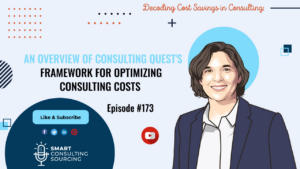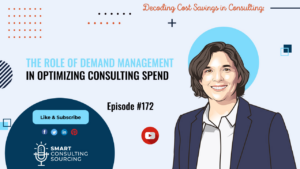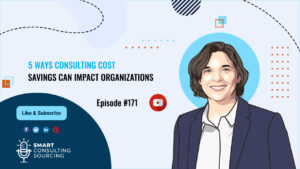Hello and a warm welcome back to Smart Consulting Sourcing, your indispensable beacon in the vast ocean of procurement. My name is Helene and I am your host today. I trust you’ve got your thinking caps on because today, we’re heading back to school – Consulting 101 if you will. The question on our slate? “What really defines consulting?” Now, if you were to ask this in a room full of professionals, you’d probably get as many answers as there are chairs, or maybe even a few more. (Perhaps from the pot plants too!) But today, you’re stuck with me and my take on it. Fear not, for I promise an enlightening exploration, with maybe just a sprinkle of wit.
But before we plunge into the deep end, let’s take a brief stroll down memory lane and recap last week’s episode, which, if I may say, was an absolute cracker.
Traditionally, consulting procurement was the domain of executive leaders, laser-focused on project scope and management. But as we discussed, there’s so much more beneath the surface. Often, the crux, like sourcing top-tier consultants and honing negotiation strategies, doesn’t get the spotlight it deserves.
But times are changing. Progressive procurement teams are no longer just counting pennies. They’re assessing the entire value spectrum of a consulting project. And that means aligning projects with long-term visions, meticulously selecting consultants, and overseeing these endeavors for maximum impact.
A quote by Bill Gates rings true here: focus is key. In consulting procurement, it’s not just about short-term savings but the broader, more impactful picture.
If there’s a golden nugget from our last chat, it’s this: The true value in consulting goes beyond immediate savings. It’s in the lasting impact, the strategic alignment, and the continuous evolution toward greater success.
So, as we wrap up last week’s reflections, remember: in the world of consulting, every decision we make crafts the bigger story of our organization.
Didn’t catch our last broadcast? Tune in via Spotify, Apple Podcast, or YouTube. For a more in-depth understanding, navigate to consultingquest.com. Immerse yourself in our white papers, ebooks, and podcast transcripts. And if you fancy, spread the word to your colleagues and grace us with a review. Your insights don’t just matter—they drive us. They inspire us to refine and elevate our content offerings. So let’s champion this pursuit of insights hand in hand.
What Is Consulting: The Historical Context, and the Origin and Evolution of the Term
Today’s pressing question: “What truly defines consulting?” To understand this, we need to trace back its origins. The term made its way to the English language in the 16th century from the French word “consulter.” Historically, this meant seeking advice, looking for information, or asking an expert. The roots go even deeper to the Latin “consultare,” which encompasses reflection, deliberation, and advice-seeking.
Bringing it to the present, the Cambridge dictionary simplifies it as: “the activity or business of giving expert advice about a particular subject.” Essentially, at the heart of consulting, past or present, is the act of providing expert advice. It seems the core essence of the word hasn’t wavered much through the ages.
Nowadays, it seems like everyone and their dog is a “consultant” of some kind. From bridal consultants (let’s be real, they’re essentially wedding planners) to real estate consultants (often just a fancy term for real estate agents), the title has become a tad… ubiquitous.
The Modern Landscape of Consulting Sourcing: Diverse Specializations
However, when we peel back the layers, consulting typically narrows down to three main sectors: management, IT, and engineering. And a fun little tidbit for you: when you stumble across the word “consulting” in media, there’s an 80% chance it’s referring to management consulting. So, while the world of consulting might seem vast and varied, here at “Smart Consulting Sourcing”, we’re zoning in on the heart of the matter: management consulting.
Demystifying Management Consulting Sourcing
Alright, let’s demystify this creature called “management consulting sourcing.” If we were to pop open the Cambridge Dictionary – a favorite pastime of mine, by the way – we’d find it described as “the job of giving advice to companies about the best ways of managing and improving their businesses.” Quite succinct, isn’t it? But honestly, it’s spot on. In its essence, management consulting is all about offering B2B services to help businesses level up. So while the term might sound grandiose, at its core, it’s all about enhancing and evolving.
When we talk about internal consulting, we’re drawing from the Cambridge Dictionary’s definition: a scenario where someone within an organization seeks advice from a department possessing specialized knowledge or skills on a particular subject. Whether you’re dealing with external or internal consulting, the constant element here is this: it’s about seeking specialized expertise and guidance on a defined subject.
Now, when diving into the world of management consulting, there’s a diversity in the nature of assignments. Let’s break it down:
Projects: The majority of consulting assignments fall under this category. They have a defined start and end with clear deliverables set out at the beginning. It’s all about achieving specific outcomes within a set timeframe.
Retainers: This is a more consistent engagement. A consultant dedicates a portion of their time exclusively to a client, regardless of whether that time is fully utilized. It’s common for roles requiring consistent touchpoints, like personal coaching or advisory roles.
One-off assignments: As the name suggests, these are unique, standalone tasks or events, often conceptualized and executed by consultants. This could be a specialized training session, an exclusive workshop, or any tailor-made engagement.
Management consulting is versatile. Whether you’re after a comprehensive solution, consistent advice, or a unique engagement, there’s an approach to fit the bill. And just like that, consulting retains its dynamic and adaptive character, ever-ready to cater to diverse business needs.
Alright, folks, since project-based work is the big player in the consulting world both in terms of sheer volume and the financials, let’s zoom in on that today. Imagine, if you will, a vast 2D matrix. On one side, you’ve got all the industries you can think of – from aerospace to zoological studies. On the other side, you’ve got the various functions or capabilities of a company. So, say you’re knee-deep in strategy at a dairy company. Believe it or not, there are consultants out there whose entire wheelhouse is—yep, you guessed it—strategy for the dairy industry.
Overarching Consulting Capabilities
Next week, we’ll dive deep into the nuances of these capabilities, their subdivisions, and some hands-on project examples. But for now, let me give you a snapshot of these overarching capabilities:
Strategy & Management: The master blueprint. This is about defining direction, setting goals, and ensuring the company is on the right path to achieving them.
Sales & Marketing: The art and science of selling. It focuses on customer acquisition, brand presence, and strategies to boost revenue.
Human Capital: Essentially, the people factor. From talent acquisition to training and development, it’s all about maximizing the potential of a company’s human resources.
Operations: The heartbeat of the business. This concerns optimizing processes, supply chain management, and ensuring the day-to-day runs smoothly.
Technology & Digital: In other words, IT and its evolutions. This dives into leveraging technology, from implementing new systems to optimizing digital operations.
Research & Development: The innovation engine. It’s about developing new products, services, or processes and staying ahead of the curve.
Finance & Risk: Numbers mostly. This revolves around financial planning, managing risks, and ensuring a company’s fiscal health.
The Anatomy of a Management Consulting Project
Now let’s dissect the anatomy of a management consulting project. Let’s roll up our sleeves and dig into what goes on behind those polished presentations and crisp suits.
We kick things off by onboarding the consultants. With the proposal’s ink having barely settled, our consultants are ushered in, reminiscent of that nervous energy from the first day of school. They’re met with a hearty welcome, handed a detailed dossier brimming with essential insights, and maybe, just maybe, given a gentle nudge about certain company tales best left unspoken. But don’t be fooled; this phase isn’t solely about information handovers. Beyond laying the groundwork, it’s the golden period where we dive deeper: meticulously detailing the execution mechanics, identifying champions and key stakeholders, pinpointing potential landmines, and setting the scene for success.
Moving right along, we then find ourselves in the diagnosis phase. Think of it as the consultants donning their detective hats. Here, they plunge into the sea of data, engage in enlightening conversations with key stakeholders, and embark on a mission to unearth patterns, dig out root causes, and unravel the knots causing those pesky problems. And while they’re at it, there’s often a dash of benchmarking. After all, who doesn’t like to see how they stack up against the competition? A touch of healthy competition and perhaps a nudge towards industry best practices can illuminate the path forward.
Following our in-depth diagnosis, we transition to the recommendations phase. It’s here that consultants, armed with their recent findings and backed by their industry or capability expertise, dissect the various options on the table. Instead of simply throwing solutions at you, they weigh the implications of each option on your business, evaluating the potential ripple effects. By the end of this phase, you’re not just presented with a smorgasbord of choices. Rather, you receive nuanced recommendations underpinned by well-thought-out reasons, steering you towards what they believe is the best course of action. It’s less about “Here are the options” and more about “Here’s what we think, and here’s why.”
Now, while some projects might wrap up at the recommendations, consulting, in its ever-versatile nature, often goes a step further. But there’s a little intermission first: a crossroads moment if you will. The project’s steering committee, perhaps even the company’s top brass, convene to make a pivotal decision. It’s the classic “go-no go” juncture, determining which among the proposed options they’re hitching their wagon to.
Once that’s squared away, we then delve into crafting the roadmap. It’s the art and science of connecting the dots—spanning from our starting point, the diagnosis, to our chosen destination. And this isn’t just any path—it’s a carefully plotted journey, ensuring the transition is as smooth and strategic as possible. After all, knowing your destination is only half the battle; charting the optimal route is where the magic truly happens.
At this juncture, we find ourselves at yet another pivotal crossroads. There’s a palpable air of anticipation, another defining “go-no go” moment looming. The roadmap, with its strategic turns and potential detours, is up for scrutiny. Is it getting the green light? And if it does, another critical choice awaits: do we continue this journey with our trusted consultants or take the reins internally?
If the decision is to forge ahead, we transition into the implementation phase. Here, the rubber meets the road. The meticulously crafted roadmap is set into motion. It’s not just about following the path but managing the inevitable changes and challenges that arise. Throughout this phase, there’s a diligent monitoring of progress, ensuring that the journey stays true to its intended course and the destination remains in clear sight. After all, a well-laid plan is only as good as its execution.
Every time we reach one of these pivotal “go-no go” intersections, the consultants, hand in hand with the internal project manager, meticulously prepare presentations tailored for the Steering Committee. These aren’t your run-of-the-mill slide decks; they are strategic, concise, and designed to inform pivotal decisions.
While these presentations often serve as the grand finale for each phase, punctuating its conclusion, it’s worth noting that they aren’t the sole artifacts of the consultants’ efforts. Along the journey, after each significant activity or milestone, you’ll find intermediary deliverables — checkpoints. These documents capture the consultants’ findings up to that moment and outline the road ahead. They serve as both a record of progress and a beacon for the next steps in the consulting adventure.
As with any well-executed endeavor, a consulting project concludes with a thorough wrap-up. Think of it as tying a neat bow on the exhaustive efforts of both the client and consultants. At this stage, the client goes through a checklist of sorts, ensuring every deliverable mapped out in the project’s infancy has indeed been provided. It’s also the moment for a financial check-in, ensuring all outstanding invoices, barring the last ones, have been settled.
This wrap-up isn’t solely a backward glance; it’s also forward-looking. It’s the moment for a preliminary debriefing with the consultants, providing feedback and insights that can benefit future engagements. Crucially, this phase is about ensuring a smooth transition for when the consultants exit stage left. And it’s worth emphasizing the word “finalize” here. While the details are cemented during the wrap-up, the essence of this transition plan should be conceived from the get-go, ideally outlined as early as the RFP process. This foresight ensures continuity and sustained progress even after the consultants have taken their bow.
What Is Consulting Sourcing – A Summary of Key Aspects
After our insightful journey today, I hope you’ve gotten a clear panorama of the consulting universe. Let’s weave together the threads of our discussion.
We can trace the word ‘consulting’ back to its roots. It all started with the French term ‘consulter’ and its Latin predecessor ‘consultare.’ Both words whisper the essence of seeking advice and reflection. And centuries later, consulting still revolves around offering that expert insight in our modern boardrooms and Zoom calls.
In today’s bustling world, you might stumble upon a consultant for just about anything— from weddings to wines. But when we distill it down, you’ll find this trio predominantly: management, IT, and engineering. And out of these, management consulting seems to stand under the spotlight the most.
Consulting follows a structured approach. The process begins with a comprehensive onboarding to ensure that both consultants and clients have a clear understanding of the objectives. After this initial phase, a thorough diagnostic assessment is conducted to identify the challenges and needs of the client organization. Based on this assessment, the recommendation phase follows, during which consultants analyze the data and insights gathered to propose the most effective strategies and solutions.
Once a direction is decided, the roadmap phase charts the journey from the current reality to the desired future. The real magic happens in the implementation phase, turning strategy into tangible action.
At critical junctures, strategic presentations serve as pivotal moments, determining the trajectory of the initiative. And as the engagement reaches its climax, the wrap-up ensures every commitment is met, and a transition plan is in place for a seamless post-consulting continuation.
Consulting is a blend of expert advice, strategic planning, and meticulous execution to amplify an organization’s success.
Alright, dear listeners, mark your calendars and set those reminders because next week’s episode promises to be enlightening! We’ll dive deep into ‘Capabilities & Services,’ where we’ll lay out the vast panorama of consulting services. Ever wondered precisely what consultants are up to behind those polished presentations? We’ll unravel the mystery for you, offering our unique taxonomy of consulting services and providing real-world examples of projects under each capability. So, don’t miss out on this, I hope, interesting journey only on Smart Consulting Sourcing.
Till then, stay safe and keep up the smart consulting sourcing game! Remember, I’m always game for a chat if you have any questions or need guidance with your consulting procurement initiatives. Feel free to connect with me on LinkedIn or drop me an email.
Au revoir for now, and happy sourcing!







